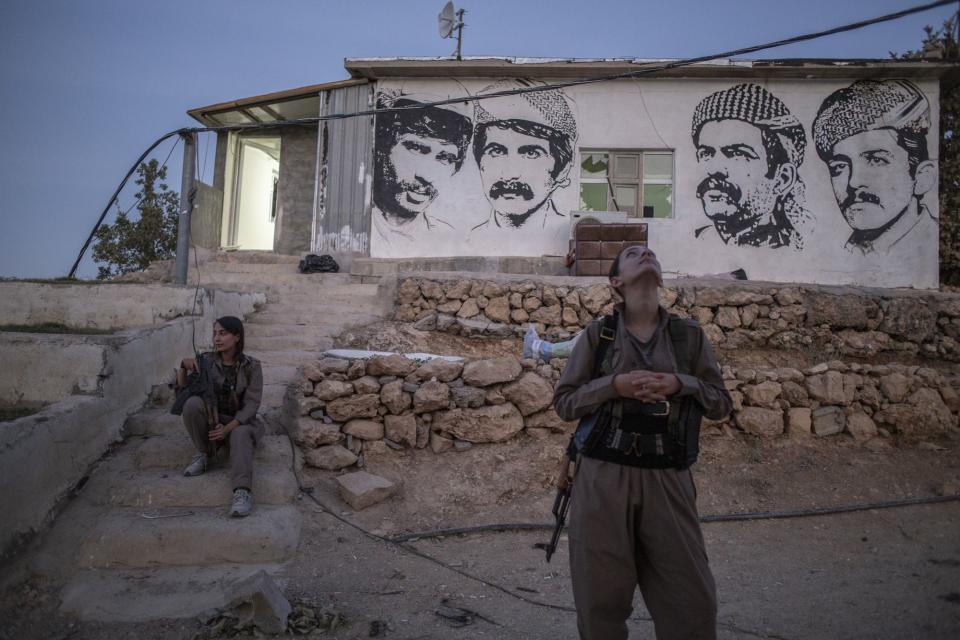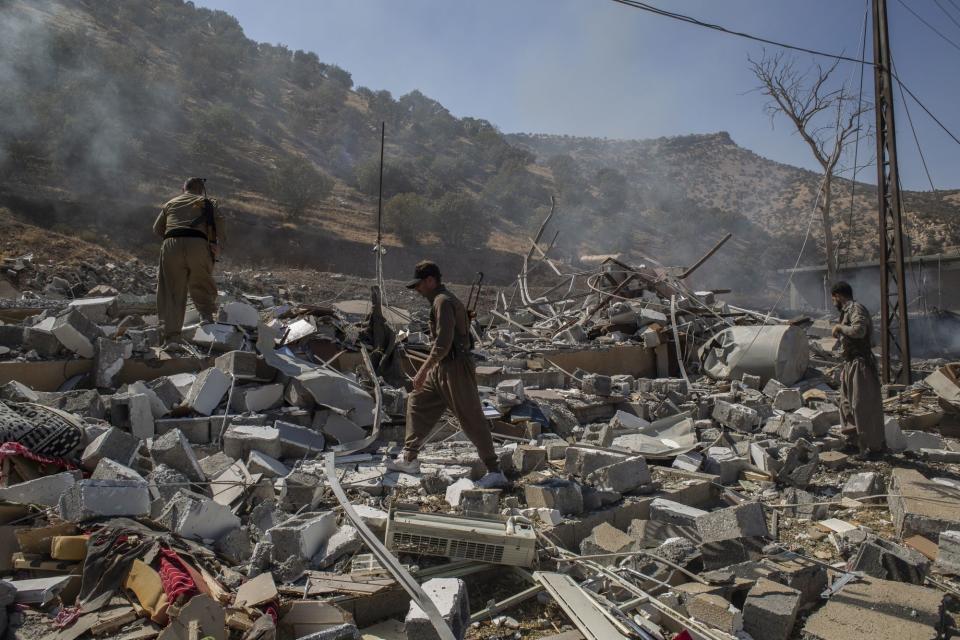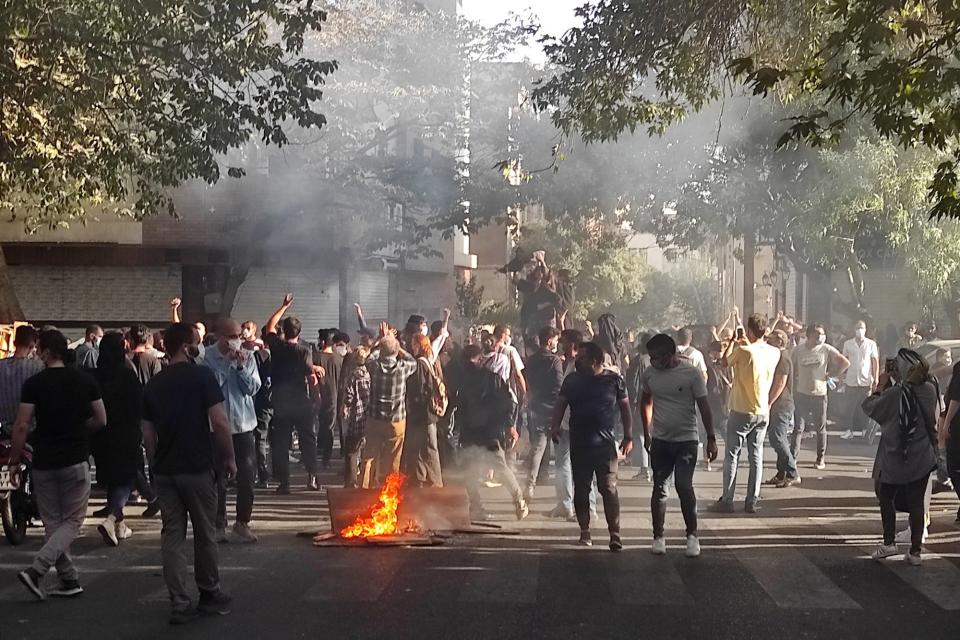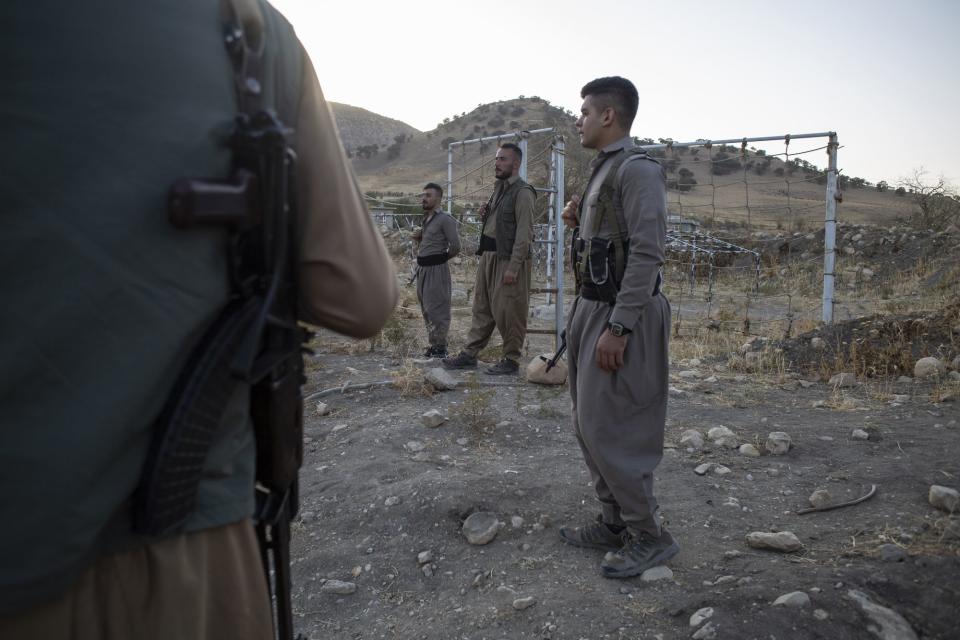Iran’s Deadly Protests Unite a Nation Behind an Old Struggle
(Bloomberg) --
Most Read from Bloomberg
Houston Mogul’s $75 Million Win on Astros Hits Caesars Hardest
Elon Musk Walks Back on Twitter Job Cuts, Blue Checks in Second Week
Ukraine Latest: US and Russia Discussed Containing War, WSJ Says
COP27 Latest: Coal Deal Provides Counterpoint to Record Demand
It took a drip-feed of information over several hours before Kurdish activist Chiako Fatehi discovered it was his older brother Ramin who had died in the Iranian jail cell.
At around 9 p.m. on Oct. 21, a family member received a call from an unknown number and was told to report to a Ministry of Intelligence detention center in Sanandaj, the capital of Iran’s Kurdistan province, according to Fatehi. They were shown into a room where they were told to identify a dead man. Ramin, 46, had been arrested at a friend’s house.
“They said he killed himself in his cell while he was in solitary confinement,” Fatehi, 36, said by phone from Sulaymaniyah in Iraq, where he’s lived in exile for the past eight years. “It didn’t make any sense.”
Like many Kurds living in Iran’s western provinces, the Fatehi family are no strangers to the scrutiny of the security forces. But the 10 million or so minority has found itself at the center of one of the biggest anti-government uprisings in Iran since the 1979 Islamic Revolution following the death in police custody of Mahsa Amini, a 22-year-old Kurdish-Iranian woman.
Making up a little over a tenth of Iran’s population, Kurdish concerns about discrimination and suppression have been confined to the political margins. Yet it’s the struggles of the Kurds along with women that have now galvanized dissent across ethnic and social lines. That sets the current demonstrations apart from previous protests and poses a more complicated challenge to the regime and its security apparatus.
Women have always been treated as though they are a minority or a second-class gender, on the margins, said Fatemeh Karimi, president of the Paris-based Kurdistan Human Rights Network. Whether it's Kurds or women “it’s the minorities that started these protests and set its foundations,” she said. “We see solidarity with minorities. Kurds have always been portrayed as being separatists and governments have always exploited this, but they haven’t succeeded this time.”How Iran’s Hijab Protests Stoked Broader Public Anger: QuickTake
Despite the police crackdown, the protests haven’t subsided. On Oct. 26, a mourning ceremony for Amini, who was known to family and friends by her Kurdish name Zhina, prompted a surge in demonstrations across the country. Thousands of businesses went on strike, students walked out and protests even shook Tehran’s Grand Bazaar, a traditional linchpin of support for the clerical establishment.
Three days later, 32-year-old Fereshteh Ahmadi was shot dead by security forces in the Kurdish city of Mahabad while watching protests from the rooftop of her home, according to the Hengaw Organization of Human Rights.
Amini was arrested on Sept. 13 for allegedly flouting Islamic dress codes for women. She died three days later after collapsing into a coma at the police station. Iranian officials have said she had underlying health conditions and probably suffered heart failure, denying any wrongdoing. Her family said Amini didn’t have any health issues and suspect she may have been beaten by the police..
The nationwide protests started at Amini’s funeral on Sept. 17 in her hometown of Saghez in Kurdistan province. As events escalated, officials framed them as riots incited by outside actors, labelling demonstrators as “terrorists” and “anti-revolutionaries.” The government has said nobody has been killed by security forces.
They also accused Kurdish political parties and militant groups across the border in Iraq of organizing the unrest. The Islamic Revolutionary Guard Corps, or IRGC, which has been controlling security in Iran’s Kurdish provinces since 2016, launched artillery and drone strikes on Iraq’s Kurdistan region, killing at least a dozen people.Some 60 people, including 11 children, have been killed in Iran’s Kurdish provinces alone since Amini’s funeral, according to Hengaw, which was founded in 2016 and monitors the protests from Europe and Iraq. The group says at least 4,000 people have been arrested in that time and has so far managed to identify 922 of them, including 74 children.
Protests have also galvanized minorities in other restive border provinces. In southeast Sistan-Baluchestan, where most of the population is ethnically Baluch and Sunni, more than 100 people have died. Some 82 people were killed in the city of Zahedan by security forces on Sept. 30 and at least a further 10 were killed on Nov. 4, according to London-based Amnesty International.
In both Iran's Kurdish provinces and in Sistan-Baluchestan, Hengaw and Amnesty said that security forces have been using live rounds against protesters in contrast to cities like Tehran, where police tend to use shotgun pellets.
Iran’s Students Protest Despite Warning from Revolutionary Guard
“From the day of the burial, it got really busy with protests in Sanandaj, people were everywhere, business went on strike,” said Mohammad, a 33-year-old software consultant who attended protests in the city, said, referring to Amini’s funeral. He didn’t want to be identified by his full name because of fear of reprisals. “We heard forces were being sent here from all over the country.”
The Kurds are one of the biggest stateless nationalities or ethnic groups in the world. Numbering up to 45 million, they played a critical role in defeating Islamic State in Iraq and Syria, where they have secured some autonomy. In Turkey, they have been increasing their political influence while the government continues a decades-long campaign against Kurdish militants.
In Iran, Kurds are integrated more socially than politically. Various governments over the decades have viewed Kurdish regions with suspicion, accusing activists of separatism and seeking to overthrow the leadership. Some, though, have publicly embraced Kurdish culture for political gains and to promote national cohesion, but Kurdish political parties and activities remain banned.
A coalition led by the exiled Komala Party of Iranian Kurdistan says it wants to replace the Islamic Republic with a federal system where ethnic groups can have their own local assemblies and teach their languages in schools.
Iran Indicts Hundreds as Students and Strikes Sustain Protests
Some activists see the protests as an extension of a long struggle, with Amini’s death a symbol of the state’s policies toward women and minorities. The Kurdish slogan “Women, Life, Freedom” has reverberated through towns and cities in Iran.
“For 43 years, the state has used propaganda to portray Kurds as violent separatists and we are now witnessing a sort of unity to an extent that we’ve never seen before,” said Abdullah Mohtadi, an activist and secretary general of the Komala Party. “Kurds have never felt so supported by other Iranians. We have a common pain.”
Like the PKK in Turkey, Iran officially designates groups like Komala as terrorist organizations. Scores of Kurdish political activists are in prison and many have been executed, despite protests from international rights groups and foreign governments.
Tension on the Iran-Iraq border has escalated significantly since 2016, according to Hiwa Bahrami, spokesman for the Democratic Party of Iranian Kurdistan. That was after a fresh mobilization of Peshmerga militias on the border with Iraq.
The IRGC’s Sept. 28 attack was a direct response to protests in Kurdistan province and targeted Komala party camps and bases. Iran’s military has amassed more troops on its western border since then, carrying out drills over two weeks near the northwestern border with Azerbaijan and the city of Urmia, both areas with large Kurdish populations.
That would be a low-cost way for Iran to show it can defend its borders against foreign threats at a time of domestic crisis, according to Abdolrasool Divsallar, visiting professor at the Milan-based Università Cattolica del Sacro Cuore.
“Ultimately, Iran thinks that by driving ethnic divisions it can take advantage of and build a ‘rally around the flag’ response and promote nationalism and then say that it’s forced to react under that pretext,” Divsallar said. “Some sort of scarecrow is useful for Iran in a crisis situation.”
For now, it’s the protesters who are rallying as Iranian security forces target alleged activists.
But according to Fatehi, his brother hadn’t even taken part in the demonstrations when he was arrested on Oct. 13. He had been resting at a friend’s home in Saghez after making a delivery and getting ready to drive back to Sanandaj in the afternoon, Fatehi said. He says several contacts in the city told him that Ramin died because he had been beaten severely around the head while detained.
Two other Fatehi siblings were arrested a day later, on Oct. 14, according to Chiako and the Hengaw Kurdish rights group. His sister Rada, 48, was apprehended at her home and another brother, 41-year-old Wurya, was taken from their father’s home, both in Sanandaj.
Dozens of phone calls and questions to the intelligence ministry and police in Sanandaj about their welfare have yielded nothing. They fear the only information they’re likely to get will be another late night phone call ordering them to identify a dead body.
“This revolution that’s happening in Iran right now isn’t about the Kurdish region or opposition groups, it’s all about people who just want their rights,” Fatehi said. “It needed a trigger — all the grievances and motives were already there — and that trigger was Zhina Amini’s death.”
--With assistance from Sylvia Westall and Selcan Hacaoglu.
Most Read from Bloomberg Businessweek
Seizing a Russian Superyacht Is Much More Complicated Than You Think
El Salvador’s $300 Million Bitcoin ‘Revolution’ Is Failing Miserably
US Housing Hit by Spiraling Mortgage Rates as Inflation Persists
Adobe Is Trying to Spend $20 Billion to Buy Back Its Swagger
Yeezy Roller Coaster Ended With Two-Minute Phone Call at Adidas
©2022 Bloomberg L.P.





